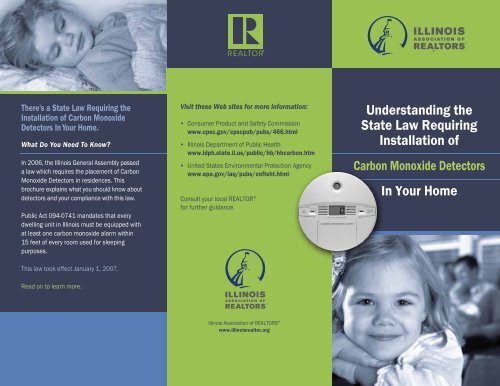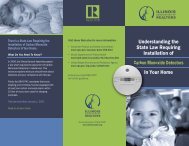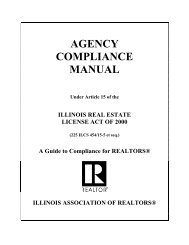Carbon Monoxide Detectors - Illinois Association of REALTORS
Carbon Monoxide Detectors - Illinois Association of REALTORS
Carbon Monoxide Detectors - Illinois Association of REALTORS
- No tags were found...
You also want an ePaper? Increase the reach of your titles
YUMPU automatically turns print PDFs into web optimized ePapers that Google loves.
There’s a State Law Requiring theInstallation <strong>of</strong> <strong>Carbon</strong> <strong>Monoxide</strong><strong>Detectors</strong> In Your Home.What Do You Need To Know?In 2006, the <strong>Illinois</strong> General Assembly passeda law which requires the placement <strong>of</strong> <strong>Carbon</strong><strong>Monoxide</strong> <strong>Detectors</strong> in residences. Thisbrochure explains what you should know aboutdetectors and your compliance with this law.Public Act 094-0741 mandates that everydwelling unit in <strong>Illinois</strong> must be equipped withat least one carbon monoxide alarm within15 feet <strong>of</strong> every room used for sleepingpurposes.This law took effect January 1, 2007.Read on to learn more.Visit these Web sites for more information:• Consumer Product and Safety Commissionwww.cpsc.gov/cpscpub/pubs/466.html• <strong>Illinois</strong> Department <strong>of</strong> Public Healthwww.idph.state.il.us/public/hb/hbcarbon.htm• United States Environmental Protection Agencywww.epa.gov/iaq/pubs/c<strong>of</strong>tsht.htmlConsult your local REALTOR®for further guidance.Understanding theState Law RequiringInstallation <strong>of</strong><strong>Carbon</strong> <strong>Monoxide</strong> <strong>Detectors</strong>In Your Home<strong>Illinois</strong> <strong>Association</strong> <strong>of</strong> <strong>REALTORS</strong>®www.illinoisrealtor.org
RESPONSIBILITIES OF LANDLORDS AND TENANTSIN A MULTI-FAMILY BUILDING WHERE UNITS ARE BEING RENTED OUT, WHO MUST FURNISH THE ALARM?WHO MUST MAINTAIN IT?The law specifies that it is the responsibility <strong>of</strong> the owner to supply and install all required alarms. So, while theowner <strong>of</strong> a multi-dwelling unit must supply and install all required alarms, the tenant is responsible for thetesting and general maintenance within their unit, including the responsibility to replace any required batteries,and to notify the owner or the authorized agent in writing <strong>of</strong> any deficiencies that the tenant cannot correct.The owner is further required to give one tenant per dwelling unit written information regarding alarm testingand maintenance and must ensure that the batteries are in operating condition at the time the tenant takespossession <strong>of</strong> a dwelling unit.WHAT IS CARBON MONOXIDE?O<strong>Carbon</strong> <strong>Monoxide</strong> (also known as CO) is a colorless,odorless, poisonous gas which can cause poisoning wheninhaled. <strong>Carbon</strong> <strong>Monoxide</strong> is produced by the incompletecombustion <strong>of</strong> organic fossil fuels such as oil, gas, or coal.In normal conditions, the combustion process (the addition<strong>of</strong> oxygen) will result in carbon in the fossil fuel, combiningwith oxygen, in the air, to produce <strong>Carbon</strong> Dioxide (CO2),the same substance we exhale when we breathe.However, if there is a lack <strong>of</strong> air for the combustion processor the heating appliance is faulty, <strong>Carbon</strong> <strong>Monoxide</strong> can beproduced. When CO is inhaled in the body it combines withthe blood, preventing it from absorbing oxygen. If a personis exposed to CO over a period, it can cause illness andeven death.WHAT IS THE MAIN REQUIREMENT UNDER THE LAW?The law mandates that every dwelling unit must beequipped with at least one approved carbon monoxidealarm in an operating condition within 15 feet <strong>of</strong> everyroom used for sleeping purposes. A dwelling unit, definedas a room or suite <strong>of</strong> rooms used for human habitation,would include a single-family residence as well as eachliving unit <strong>of</strong> a multiplefamily residence and each living unitin a mixed use building.ARE THERE ANY EXEMPTIONS TO THIS REQUIREMENT?The law exempts residential units that are in buildings that: (1)do not rely on combustion <strong>of</strong> fossil fuel for heat, ventilation orhot water; and (2) are not connected in any way to a garage;and (3) are not sufficiently close to any ventilated source <strong>of</strong>carbon monoxide. Buildings that have electric heat are exempt.ARE THERE ANY SPECIFIC REQUIREMENTS ABOUT THETYPE OF DETECTOR OR ALARM THAT MUST BE USED?The law allows three different types <strong>of</strong> alarms to be used tomeet the requirement. The alarm can be battery-powered, aplug-in style (with battery back-up) or it can be wired into theAC power line with secondary battery back-up.The <strong>Carbon</strong> <strong>Monoxide</strong> alarm must bear the label <strong>of</strong> anationally recognized testing laboratory and must comply withthe most recent standards <strong>of</strong> the Underwriters Laboratories.Look for the “UL” symbol on the package. If you are not sure,check with the retailer and read the description and theinstructions on the box containing the alarm.CAN YOU USE ONE ALARM SYSTEM TO MEET STATELAWS THAT MANDATE BOTH A SMOKE DETECTOR ANDA CARBON MONOXIDE DETECTOR?YES. The <strong>Carbon</strong> <strong>Monoxide</strong> alarm may be combined withthe smoke detector provided that combined unit emits analarm in a manner that clearly differentiates the hazard.IS THERE A PENALTY IF I DO NOT INSTALL A DETECTOR?Willful failure to install a detector is a Class B misdemeanor.Tampering with, or removing, destroying,disconnecting an alarm (except in inspection or maintenance)is a Class A misdemeanor.









